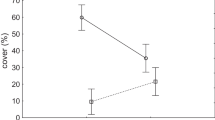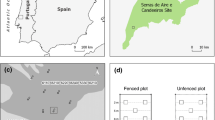Abstract
Although grazing was a part of calcareous fens’ disturbance regimes, few studies have examined the impact of grazing release in these systems, and managers are reticent to experiment with restoring grazing for management purposes. Here I describe vegetation, edaphic, and hydrologic differences in a Wisconsin calcareous fen between areas long-protected (since 1987) from cattle grazing and those protected in 2011, 2.5 years before the study. Vegetation surveys found that the long-protected areas had significantly lower floristic quality, fewer rare and specialist species, and more woody-plant encroachment than areas abandoned in 2011. Interviews with a farmer and air-photo interpretations suggested that vegetation changed in the protected areas around the time of abandonment. Known edaphic and hydrologic drivers of vegetation change in fens (volumetric water content, electrical conductivity, nutrient availability) could not account for the vegetation differences between the two areas. Site histories found no events accounting for these vegetation differences other than grazing. These results suggest that grazing release led to increased shrub encroachment, decline in floristic quality, and-possibly- a decline in specialist and rare species.




Similar content being viewed by others
Data availability
The data are embargoed due to the presence of NHI-listed species. Once cleared with WDNR NHI, data will be made available to all reasonable requests to the author.
References
Amon J, Thompson C, Carpenter Q, Miner J (2002) Temperate zone fens in of the glaciated Midwestern USA. Wetlands 22:301–317
Bart D (2006) Integrating local knowledge and manipulative experiments to find the causes of environmental change. Front Ecol Environ 4:541–546
Bart D (2010) Using weed control knowledge from declining agricultural communities in invasive-species management. Hum Ecol 38:77–81
Bart D, Davenport T, Yantes A (2013a) Preliminary report on abiotic resistance to plant invasions in calcareous fens. Wisconsin Department of Natural Resources (WDNR), Madison (WI)
Bart D, Yantes A, Davenport (2013b) Where are the rare species? The importance of land-use legacies in predicting rare and specialist plants in WI fens. In: 5th World conference on ecological restoration, Society for Ecological Restoration, Madison, WI, 7 Oct 2013
Bart D, Davenport T, Yantes A (2016) Environmental predictors of woody plant encroachment in calcareous fens are modified by biotic and abiotic land-use legacies. J Appl Ecol 53:541–549
Bart D, Booth, E Loheide S, Bernthal T (2020a) The Fen Drawdown Impact (FDI) Scenario models: a users guide. Final report submitted to the United States Department of Environmental Protection (USEPA), 1 Mar 2020
Bart D, Booth E, Loheide S, Bernthal T (2020b) Impacts of groundwater extraction on calcareous fen floristic quality. J Environ Qual 49:723–734
Bedford B, Zimmerman E, Zimmerman J (1974) Wetlands of Dane County, Wisconsin. Wisconsin Department of Natural Resources, Madison, WI
Bentley J (1989) What farmers don’t know can’t help them: the strengths and weaknesses of indigenous technical knowledge in Honduras. Agric Hum Values 6:25–31
Briggs J, Knapp A, Brock B (2002) Expansion of woody plants in tallgrass prairie: a fifteen-year study of fire and fire-grazing interactions. Am Midl Nat 14:297–294
Brown J, Archer S (1999) Shrub invasion of grassland: recruitment is continuous and not regulated by herbaceous biomass or density. Ecology 80:2385–2396
Brundage J (2010) Grazing as a tool for controlling Phragmites australis and restoring native plant biodiversity in wetlands. MS Thesis, University of Maryland
Carpenter Q (1995) Toward a new definition of calcareous fen for Wisconsin (USA) Ph. D. Dissertation, University of Wisconsin-Madison
Chuong J, Huxley J, Spotswood E, Nichols L, Marotte P, Suding K (2016) Cattle as dispersal vectors of invasive and introduced plants in a California annual grassland. Rangel Ecol Manag 69:52–58
Cobos D, Chambers C (2010) Calibrating the ECH20 soil moisture sensor. Application Note, Decagon Devices. http://cn.ictinternational.com/content/uploads/2014/03/13393-04-CalibratingECH20SoilMoistureProbes.pdf. Accessed May 1 2016.
Coughenor M (1991) Spatial components of plant-animal interactions in pastoral, ranching, and native ungulate ecosystems. J Range Manag 44:530–542
Curtis J (1959) Vegetation of Wisconsin. University of Wisconsin Press, Madison, WI
Czarapata E (2005) Invasive plants of the upper Midwest. The University of Wisconsin Press, Madison, WI
Davenport T, Bart D, Carpenter Q (2014) Altered plant-community composition and edaphic features associated with plowing in southern WI fens. Wetlands 34:449–457
Davis G, Gray A (2015) Don’t let spurious accusations of pseudoreplication limit our ability to learn from natural experiments (and other kinds of ecological monitoring). Ecol Evol 5:5295–5304
De Bello F, Lepš J, Sebastiá M (2006) Variations in species and functional plant diversity along climatic and grazing gradients. Ecography 29:801–810
Eriksson O, Cousins S, Bruun H (2002) Land-use history and fragmentation of traditionally managed grasslands in Scandinavia. J Veg Sci 13:743–748
Fleischner T (1994) Biological costs of livestock grazing in western North America. Conserv Biol 8:629–644
Fojt W, Harding M (1995) Thirty years of change in the vegetation communities of three valley mires in Suffolk England. J Appl Ecol 32:561–577
Frost I, Rydin H (1997) Effects of competition, grazing, and cotyledon nutrient supply on growth of Quercus robur seedlings. Oikos 79:53–58
Gauch H (1982) Multivariate analysis in community ecology. Cambridge University Press, New York
Harrington J, Kathol E (2009) Responses to shrub mid-story and herbaceous layers to managed grazing and fire in a North American Savanna (Oak Woodland) and Prairie landscape. Restor Ecol 17:234–244
Hart R (2001) Plant biodiversity on shortgrass steppe after 55 years of zero, light, moderate, or heavy cattle grazing. Plant Ecol 155:111–118
Hickman K, Hartnett D, Cochran R, Owensby C (2004) Grazing management effects on plant species diversity in tallgrass prairie. J Range Manag 57:58–65
Holte K (1966) A floristic and ecological analysis of the Excelsior Fen complex in northwest Iowa. Dissertation, University of Iowa
Jacobson G, Almquist-Jacobson H, Winne J (1991) Conservation of rare plant habitat: insights from the recent history of vegetation and fire at crystal fen, Northern Maine USA. Biol Conserv 57:287–304
Kogler B, Howell E (1981) Shrub invasion of wetland (Wisconsin). Restor Manag Notes 1:15
Marty J (2005) Effects of cattle grazing on diversity in ephemeral wetlands. Conserv Biol 19:1625–1632
Marty J (2015) Loss of biodiversity and hydrologic function in seasonal wetlands persists over 10 years of livestock grazing removal. Restor Ecol 23:548–554
Matson E, Bart D (2013) Interactions among fire legacies, grazing, and topography predict shrub encroachment in post-agricultural Páramo. Landsc Ecol 28:1829–1840
McCoy M, Rodríguez J (1994) Cattail (Typha dominguensis) eradication methods in the restoration of a tropical, seasonal, freshwater marsh. In: Mitsch JW (ed) Global wetlands: old world and new. Elsevier Science, Netherlands, pp 469–482
McCune B, Grace J (2002) Analyses of ecological communities. MJM Software, Gleneden Beach, Oregon
Middleton B (2002a) Winter burning and reduction of Cornus sericea in sedge meadows in southern WI. Restor Ecol 10:723–730
Middleton B (2002b) Non-equilibrium dynamics of sedge meadows grazed by cattle in southern Wisconsin. Plant Ecol 161:89–110
Middleton B, Holstein B, Van Diggelen R (2006) Biodiversity management of fens and fen meadows by grazing, cutting, and burning. Appl Veg Sci 9:307–316
Proulx M, Mazumder A (1998) Reversal of grazing impact on plant species richness in nutrient-poor vs. nutrient-rich ecosystems. Ecology 79:2581–2592
Sjörs H (1950) On the relation between vegetation and electrolytes in north Swedish mire waters. Oikos 2:241–258
Swink F, Wilhelm G (1994) Plants of the Chicago Region, 4th edn. Indiana Academy of Science, Indianapolis
United States Department of Agriculture (USDA) Natural Resources Conservation Service (NRCS) (2020) The PLANTS Database. National Plant Data Center. http://plants.usda.gov. Accessed 9 Jan 2020
Watkinson A, Ormerod S (2001) Grasslands, grazing, and biodiversity: editor’s introduction. J Appl Ecol 38:233–237
Wisconsin Department of Natural Resources (WDNR) Natural Heritage Inventory (NHI) (2014) Natural Heritage Inventory: Calcareous Fens. Wisconsin Department of Natural Resources, Madison, WI. http://dnr.wi.gov/org/land/er/communities/index.asp?mode=detail&CodeCPHER064WI
Zouhar K (2011) Muhlenbergia glomerata. In: Fire effects information system. U.S. Department of Agriculture, Forest Service, Rocky Mountain Research Station, Fire Sciences Laboratory. https://www.fs.fed.us/database/feis/plants/graminoid/muhglo/all.html. Accessed 9 Jan 2020
Acknowledgements
I thank Dr. John Harrington for providing comments on this manuscript. Glen Anderson provided much needed site-history information. Peter Deurkup and Thomas Meyer (both WDNR) facilitated site-history-data collection. Funding was provided by the WDNR.
Funding
Funding was provided by the Wisconsin Department of Natural Resources (WDNR) in a grant awarded to the author.
Author information
Authors and Affiliations
Contributions
The author developed the research project, obtained funding, conducted all the research and analyses, and wrote the manuscript.
Corresponding author
Ethics declarations
Conflict of interest
The author declares no conflicts of interest or competing interests.
Research involving human and animal rights
No animal research was done. All human subjects consented to the interviews and for the use of this information in this publication.
Additional information
Publisher's Note
Springer Nature remains neutral with regard to jurisdictional claims in published maps and institutional affiliations.
Supplementary information
Below is the link to the electronic supplementary material.
Rights and permissions
About this article
Cite this article
Bart, D. Vegetation changes associated with release from cattle grazing in a WI calcareous fen. Wetlands Ecol Manage 29, 67–79 (2021). https://doi.org/10.1007/s11273-020-09767-4
Received:
Accepted:
Published:
Issue Date:
DOI: https://doi.org/10.1007/s11273-020-09767-4




